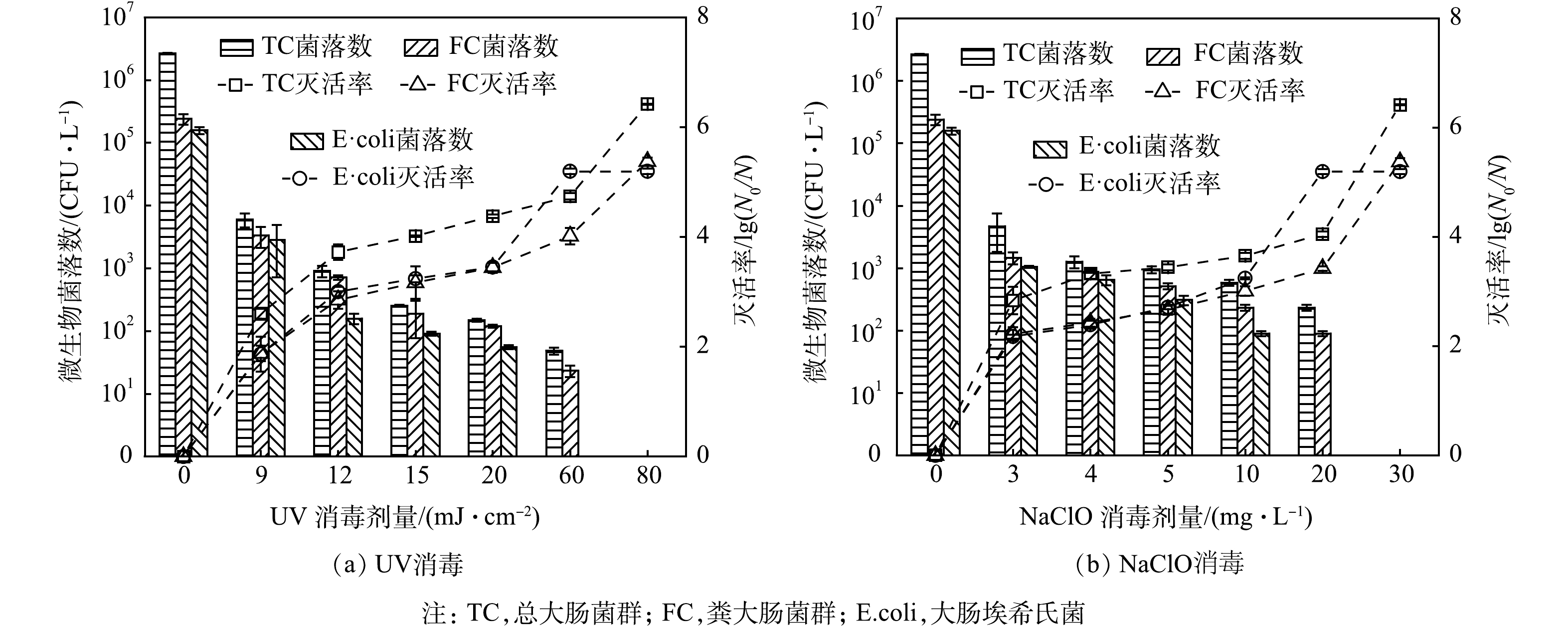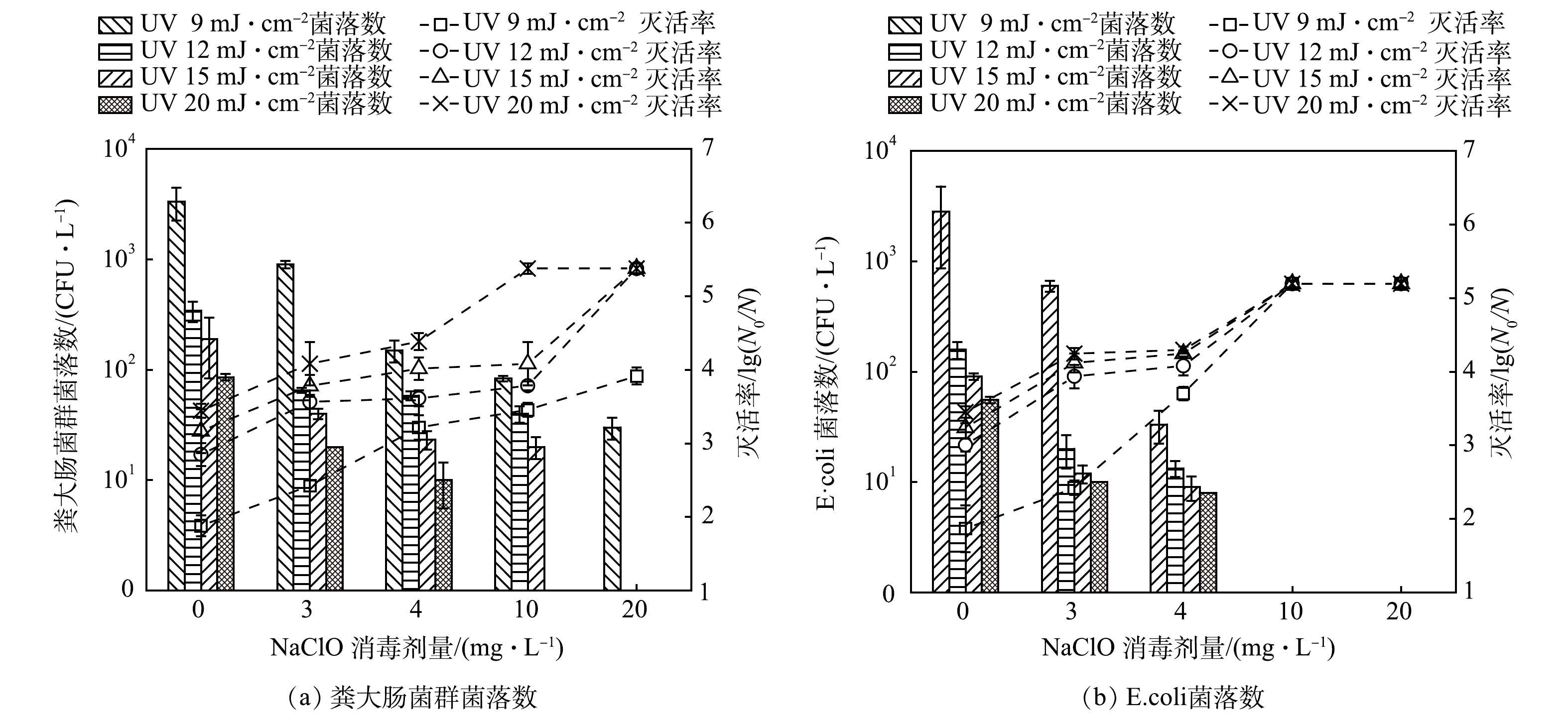-
水质安全是污水排放与再生回用的关键。病原微生物风险是保障水质安全需要优先控制的问题。总大肠菌群、粪大肠菌群和大肠埃希氏菌(E.coli)常被作为粪便污染的指示微生物,被国内外学者广泛用于评价水的生物安全性[1]。大肠菌群主要以粪口途径传播、通过侵染肠道系统引发疾病,甚至危及人的生命[2]。污水处理厂既是各种污水的汇集地,又是污水经过处理达到一定标准后重新回到生态系统或加以再生利用的重要环节[3]。污水处理厂被认为是大肠菌群的重要来源及传播场所[4]。消毒作为污水处理的最后一道工序,在灭活病原微生物、减少水传染疾病的传播等方面发挥着重要作用。在污水处理厂中,通常采用UV或NaClO消毒对大肠菌群进行灭活[5]。
有研究表明,NaClO消毒可有效灭活细菌,同时水中残留的氯具有持续消毒作用,可保证消毒后水的生物稳定性,但次氯酸钠消毒会产生消毒副产物(DBPs),威胁再生水的用水安全[6]。UV消毒可以在较低剂量下有效灭活病原微生物[7],但UV消毒无持续杀菌能力,且经UV消毒后部分细菌难以被完全杀灭而处于亚致死或活的但不可培养状态[8],这些细菌可在一定条件下通过光复活或暗修复的方式重新获得活性,进而增加再生水储存和输送过程中病原微生物二次滋生的潜在风险。
迄今为止,已有学者在UV-NaClO顺序消毒灭活病原微生物方面开展了相关的研究工作[9-10],但达到与UV或NaClO相同的消毒效果时,UV-NaClO顺序消毒在投加量的优势,消毒后水在输送,储存及再生利用过程中UV-NaClO顺序消毒控制大肠菌群二次滋生的研究却相对较少。本研究以青岛市某市政污水处理厂消毒前的深度处理出水为研究对象,分别采用UV、NaClO以及UV-NaClO顺序消毒,对比分析了在达到排放要求以及再生水不同回用标准时,UV-NaClO顺序消毒对微生物光复活与暗修复的抑制能力及其对DBPs生成量的削减作用。本研究结果可为强化污水消毒,降低污水排放与再生回用的生物安全风险提供参考。
-
本实验原水取自青岛市某市政污水处理厂,该厂进水主要为生活污水,生物处理采用A2O+MBBR工艺,深度处理工艺为混凝/沉淀/过滤及UV消毒工艺,实验期间该厂过滤后出水,水质的pH为6.93~7.17、PO43--P为0.11~0.19 mg·L−1、NH4+-N为2.26~3.40 mg·L−1、COD为27.00~30.00 mg·L−1、TOC为9.01~11.10 mg·L−1和浊度为1.69~2.94 NTU。采用经过灭菌处理的取样设备取该厂过滤后出水,将水样于4 ℃下保存并尽快进行消毒实验。
-
通过系列实验研究了不同消毒方式消毒后污水中大肠菌群的灭活效果、复活特性和DBPs生成的影响。每个实验均设3次重复。
1) UV消毒实验。UV消毒实验在自制的平行光束仪下进行。平行光束仪上部有2个功率为20 W的UV灯管,开启UV灯30 min后,用紫外辐照计检测紫外线强度。每次实验时将300 mL水样注入500 mL灭菌后的烧杯中,放入灭菌后的转子,将烧杯置于磁力搅拌器上均匀接受UV辐射,通过调节紫外强度和照射时间确定紫外辐射剂量[11]。
2) NaClO消毒实验。将一定量的NaClO溶液投加到已盛装一定体积水样的500 mL灭菌烧杯中,在磁力搅拌器的搅拌作用下接触反应30 min,用硫代硫酸钠终止反应,取消毒反应前后的水样测定其中的大肠菌群类微生物的数量。
3) UV-NaClO顺序消毒实验。将水样先经一定剂量的UV消毒后,再向其中投加一定量的NaClO溶液,在磁力搅拌器的搅动作用下消毒反应30 min,用硫代硫酸钠终止反应。
4)光复活和暗修复实验。取一定剂量消毒后的水样,分别在日光灯照射(光复活)或避光(暗修复)条件下于25 ℃恒温搅拌放置一定时间,期间定时取样,测定细菌的菌落数。
-
采用孔径为0.45 μm的滤膜对消毒前后的水样进行预处理,之后采用滤膜法对大肠菌群进行测定。截留了菌体的滤膜分为3份,1份置于品红亚硫酸钠培养基上,于37 ℃下培养24 h后转至乳糖蛋白胨半固体培养基上,于37 ℃下培养6~8 h,测定总大肠菌群的数量;1份置于M-FC培养基上,于45 ℃下培养24 h后测定粪大肠菌群的数量;1份置于品红亚硫酸钠培养基上,于37 ℃下培养24 h后转至MUG培养基上,于37 ℃下继续培养4 h后,计算大肠埃希氏菌(E.coli)的菌落数。采用顶空气相色谱法测定水中DBPs的浓度[12]。
-
采用对数灭活率来评价消毒后细菌的灭活效果,灭活率根据式(1)进行计算。利用复活百分比来表征光复活和暗修复程度,复活率百分比根据式(2)进行计算。
式中:A为灭活率,%;B为复活百分比,%;N0和N分别为消毒前和消毒后水样中的大肠菌群数量,CFU·L−1;NP 为光复活或暗修复后水样中的大肠菌群数量,CFU·L−1。
-
不同剂量下单独UV消毒或NaClO消毒对总大肠菌群、粪大肠菌群和大肠埃希氏菌(E.coli)的灭活情况如图1所示。消毒剂量对大肠菌群类微生物的灭活影响较大,随着UV剂量或NaClO投加量的增加,大肠菌群数量随之下降。当UV剂量仅为12 mJ·cm−2时,大肠菌群类微生物的灭活率即可达到接近或超过3个对数级;当NaClO投加量仅为3 mg·L−1时,大肠菌群类微生物可达到2个对数级的灭活率。此后,进一步增加消毒剂量,微生物数量下降幅度趋缓,如当UV剂量由12 mJ·cm−2增加到60 mJ·cm−2时,总大肠菌群和粪大肠菌群的灭活率仅提高不足1个对数级,当NaClO的投加量从3 mg·L−1增加到20 mg·L−1时,总大肠菌群的灭活率也仅增加了1.22个对数级。相较于其他的粪大肠菌,E.coli更易被灭活,当UV剂量达到60 mJ·cm−2时,已检测不到E.coli。完全灭活总大肠菌群或粪大肠菌群需要80 mJ·cm−2 UV或30 mg·L−1 NaClO。
当UV消毒剂量达到12 mJ·cm−2和20 mJ·cm−2时,粪大肠菌群数量可分别满足《城镇污水处理厂污染物排放标准》(GB 18918-2002)一级A排放标准[13](简称“一级A标准”)中“≤1 000 CFU·L−1”以及《城市污水再生利用绿地灌溉水质》(GB/T 25499-2010)(简称“绿地灌溉标准”)中非限制性绿地的“≤200 CFU·L−1”的要求[14]。当UV消毒剂量达到60 mJ·cm−2时,E.coli可满足《城市污水再生利用 城市杂用水水质》(GB/T 18920-2020)中“大肠埃希氏菌不得检出”的要求[15](简称“杂用水标准”)[16]。消毒后的水样要达到一级A标准、绿地灌溉标准以及杂用水标准,NaClO投加量分别需达到4、10和20 mg·L−1。
-
为探究UV-NaClO顺序消毒应用于污水消毒的可行性,在不同UV和NaClO剂量组合条件下分析了UV-NaClO顺序消毒对水样中大肠菌群的灭活效果,结果如图2所示。UV-NaClO顺序消毒更有利于大肠菌群的灭活,顺序消毒的效果好于UV或NaClO单独消毒的效果。仅采用UV消毒,当UV剂量为9 mJ·cm−2时,粪大肠菌群的菌落数可由2.4×105 CFU·L−1降至3.4×103 CFU·L−1;仅采用NaClO消毒,当NaClO投加量为3 mg·L−1时,消毒后粪大肠菌群的数量降为1.5×103 CFU·L−1;若采用UV-NaClO 顺序消毒,UV和NaClO的剂量分别为9 mJ·cm−2和3 mg·L−1时,消毒后粪大肠菌群的数量可降至9.0×102 CFU·L−1,与单独UV或单独NaClO消毒相比,粪大肠菌群的数量分别降低了73.5%和40.0%。
表1对比了达到不同处理效果时不同消毒方式所需消毒剂的最低投加量。由对比结果可知,采用UV-NaClO顺序消毒,可以在相对较低的消毒剂投加量下就可达到单一消毒剂在较高剂量下所达到的消毒效果,尤其是当需要达到的排放标准较高时,采用UV-NaClO顺序消毒的优势更加明显。例如,当出水仅需满足一级A标准,即粪大肠菌群数量≤1000 CFU·L−1时,采用UV-NaClO顺序消毒需要的UV及NaClO剂量分别为9 mJ·cm−2和3 mg·L−1,同单独UV或NaClO消毒在消毒剂投加量上相比未表现出较大优势;若出水需满足杂用水标准规定的E.coli不得检出的要求,单独UV或NaClO消毒需要的UV或NaClO剂量分别为60 mJ·cm−2或20 mg·L−1,而采用UV-NaClO顺序消毒则仅需9 mJ·cm−2 UV和10 mg·L−1 NaClO。若达到完全灭活粪大肠菌群的目标,UV-NaClO顺序消毒在投加量上的优势则更加明显。
UV-NaClO顺序消毒相比单一消毒剂所具有的优势,可能是由于微生物对不同消毒方式的耐受程度不同。有研究表明,经UV消毒后磺胺类抗生素耐药菌的比例显著升高,而低剂量的NaClO消毒则能有效降低此类细菌的比例[17-18],因而投加低剂量的NaClO即可达到或超过高剂量UV消毒所达到的效果。同样有一些细菌(Cryptosporidium)对氯消毒具有很强的耐受能力[19],对于这类细菌采用低剂量的UV辐射也可能达到较好的灭活效率。因而,UV-NaClO顺序消毒中UV和NaClO具有协同效应,可以灭活单一消毒剂所不能完全灭活的微生物,且可以在UV和NaClO剂量均不高的组合方式下即可达到更优的消毒效果。
-
在满足相同出水标准时,经UV-NaClO顺序消毒后微生物的复活能力明显低于单独UV消毒(图3),尤其是当NaClO的投加量较高时,对微生物复活的抑制作用更为明显。在满足一级A排放标准的消毒剂投加量下,单独UV(12 mJ·cm−2)消毒后分别经24 h光复活和暗修复后,粪大肠菌群的复活率为7.97%和4.96%,而经UV-NaClO(UV剂量9 mJ·cm−2和3 mg·L−1 NaClO )顺序消毒后粪大肠菌群复活率仅为3.21%和0.84%,较单独UV消毒分别减少了4.76%和4.12%。当UV剂量不变,NaClO投加量增加到4 mg·L−1时,UV-NaClO顺序消毒后在相同的复活时间内,粪大肠菌群的复活率仅为0.3%(光复活)和0.01%(暗修复),虽然NaClO投加量仅增加了1 mg·L−1,但细菌复活率明显降低。
当UV剂量为60 mJ·cm−2时,单独UV消毒可完全灭活E.coli,但在光照下经3 h复活后,E.coli的数量即可增加为33 CFU·L−1;经24 h的暗修复,E·coli可增加至66 CFU·L−1(图3(e))。采用UV-NaClO顺序消毒,当UV剂量为9 mJ·cm−2和NaClO投加量10 mg·L−1也可完全灭活E.coli,但是,消毒后的水样无论是在光照下还是在暗处,24 h内均未出现细菌复活的现象。因而,在UV消毒后,继续投加少量的NaClO可以减小微生物复活的概率。UV-NaClO顺序消毒之所以可以抑制微生物的复活主要是由于NaClO作为强氧化剂,其对微生物的灭活作用是通过氧化细胞中的酶、阻止蛋白质合成这一途径实现的,这种对细胞的破坏作用不具有可逆性,因此,被NaClO灭活的微生物不会出现复活的现象。
当处理后出水再生回用于绿地灌溉时,仅采用UV消毒,在光照条件下,3 h后再生水中的粪大肠菌群数即会超标,采用UV-NaClO顺序消毒,6 h后粪大肠菌群数可能会超标;当处理后出水再生回用于城市杂用时,仅采用UV消毒,在光照条件下,3 h后E.coli的数量超标,而采用UV-NaClO顺序消毒,24 h后E·coli数量仍然可以满足标准要求。同光复活相比,细菌暗修复的能力较弱,如仅采用UV消毒满足绿地灌溉或城市杂用标准时,经24 h暗修复后,细菌数量才出现超标的现象,采用UV-NaClO顺序消毒后的水样,在暗处放置24 h后,细菌数量均未出现超标的现象。因而,考虑到再生水输配管网的长度以及再生水使用的非连续性特点,采用UV-NaClO顺序消毒更有利于保证再生水的水质安全。同时在实际工程中,再生水的输送及储存应尽量采用密闭式系统,以降低消毒后细菌复活的可能性。
通过本研究可知,单独 UV 消毒不能有效的防止大肠菌群从污水处理厂向环境中传播,而采用UV-NaClO顺序消毒可在一定程度上抑制大肠菌群的二次滋生,减少了消毒后水在输送,储存及再生利用过程中潜在的生物风险。
-
为考察UV-NaClO顺序消毒对DBPs生成的影响,采用顶空气相色谱法分析了不同方式消毒后三氯甲烷、四氯化碳、二溴一氯甲烷和一溴二氯甲烷的生成量,并计算了DBPs的总生成量,结果如表2所示。在满足相同出水标准时,UV-NaClO顺序消毒DBPs的生成量明显低于单独NaClO消毒。尤其是当需要达到的出水标准越高时优势越明显。满足一级A排放标准时,采用UV-NaClO顺序消毒产生的总DBPs比单独NaClO消毒可减少24.53%;达到绿地灌溉标准时,单独NaClO消毒生成的总DBPs量为11.56 μg·L−1,UV-NaClO顺序消毒生成的总DBPs为5.79 μg·L−1,比NaClO消毒DBPs生成量降低了49.91%;满足杂用水标准时,UV-NaClO顺序消毒总DBPs的生成量比单独NaClO消毒可降低76.87%;在达到完全灭活粪大肠菌群的条件下,DBPs的减量可高达77.85%。
DBPs的生成量同氯的投加量密切相关,随着氯投加量的增加,DBPs的生成量显著增加[20]。采用UV-NaClO顺序消毒之所以可以降低DBPs的生成量,主要是由于在达到相同消毒效果时UV-NaClO顺序消毒所需的NaClO投加量低于单独NaClO消毒时的投加量,而且,当需要达到的消毒标准越高时,所需NaClO投加量低的优势越明显,如完全灭活粪大肠菌群时,单独NaClO消毒需要的NaClO投加量为30 mg·L−1,而采用UV-NaClO顺序消毒则只需投加10 mg·L−1的NaClO,因而,采用UV-NaClO顺序消毒可大幅降低DBPs的生成量。
大部分DBPs具有潜在的致癌、致畸和致突变毒性,较高浓度DBPs排入水体或再生利用时会威胁生态系统安全,并对人体健康具有潜在危害[21],UV-NaClO顺序消毒可避免大量的DBPs排入水体或进入再生水利用系统,因而,其在保护人体健康与生态环境等方面更具优势。
-
1) UV和NaClO对大肠菌群的灭活具有协同效应,采用UV-NaClO顺序消毒,在UV和NaClO投加量均不高的组合方式下即可达到单独UV或单独NaClO高剂量下的消毒效果,且当需要达到的消毒标准越高时,UV-NaClO顺序消毒的优势越明显。
2)经UV-NaClO顺序消毒后,大肠菌群的光复活和暗修复能力相比单独UV消毒有所下降,NaClO投加量越高下降幅度越明显,因而,采用UV-NaClO顺序消毒可在一定程度上抑制大肠菌群的二次滋生。
3)由于在达到相同消毒效果的前提下,UV-NaClO顺序消毒可以有效降低NaClO的投加量,因而,采用UV-NaClO顺序消毒可以降低DBPs的生成量,从而降低消毒对人体健康与生态环境的潜在危害。
UV-NaClO顺序消毒对污水中大肠菌群的灭活效果
Inactivation of coliforms in wastewater by UV- NaClO disinfection
-
摘要: 紫外(UV)和次氯酸钠(NaClO)消毒广泛应用于城市污水处理中,但目前2种消毒方式均存在不足。为实现既可高效消毒又能同时降低消毒所带来负面影响的目的,通过对比研究,分析了达到与UV或NaClO相同的消毒效果时,紫外-次氯酸钠(UV-NaClO)顺序消毒所需的消毒剂量以及UV-NaClO顺序消毒对微生物复活和消毒副产物(DBPs)生成的影响。结果表明:当UV剂量为9 mJ·cm−2,NaClO投加量为3、4和10 mg·L−1时,UV-NaClO顺序消毒可达到与单独UV消毒时(剂量为12、20或60 mJ·cm−2)以及单独NaClO消毒时(NaClO投加量为4、10或20 mg·L−1)的相同消毒效果;且当需要的微生物灭活效率越高时,UV-NaClO 顺序消毒的优势越明显。同单独UV消毒相比,UV-NaClO顺序消毒后微生物的光复活率和暗修复率明显降低。当达到与单独NaClO消毒相同的微生物灭活效果时,UV-NaClO顺序消毒可有效降低DBPs的生成量,例如完全灭活E.coli,采用UV-NaClO顺序消毒,DBPs的生成量可较单独NaClO消毒降低了76.87%。本研究可为污水排放与再生利用消毒技术的选择提供参考。Abstract: Ultraviolet (UV) and sodium hypochlorite (NaClO) disinfection are widely used in wastewater treatment, but both disinfection methods have deficiencies. In order to achieve efficient disinfection while reducing the negative impact of disinfection, a comparative study was conducted to analyze the disinfectant amount required for combined UV-NaClO disinfection with the same disinfection effect as UV or NaClO and the effect of UV-NaClO disinfection on microbial reactivation and disinfection by-products (DBPs) formation. The results showed that at UV dosage of 9 mJ·cm−2 and NaClO dosages of 3, 4 and 10 mg·L−1, UV-NaClO disinfection was as effective as UV disinfection alone at UV dosages of 12, 20 or 60 mJ·cm−2 and NaClO disinfection alone at NaClO dosages of 4, 10 or 20 mg·L−1. The higher the desired microbial inactivation efficiency, the more obvious the advantages of UV-NaClO disinfection. Compared to UV disinfection alone, UV-NaClO disinfection showed significantly lower rates of microbial photo-reactivation and dark repair. Achieving the same microbial inactivation effect as NaClO disinfection alone, UV-NaClO disinfection could effectively reduce the production of DBPs, for example, achieving complete inactivation of E.coli, the production of DBPs decreased by 76.87% using UV-NaClO disinfection compared with NaClO disinfection alone. This study can provide a theoretical basis for the selection of disinfection technology for wastewater discharge and recycling.
-
Key words:
- ultraviolet /
- sodium hypochlorite /
- disinfection /
- coliforms /
- reactivation /
- disinfection by-products
-

-
表 1 不同污水排放标准下不同消毒方式所需的最小消毒剂量
Table 1. Minimum disinfection dosage required by different disinfection methods for different sewage discharge standards
出水标准 限值要求/
(CFU·L−1)UV消毒/
(mJ·cm−2)NaClO消毒/
(mg·L−1)UV- NaClO顺序消毒
UV(mJ·cm−2)/NaClO(mg·L−1)一级A标准 FC≤1000 12 4 9/3 绿地灌溉标准 FC≤200 20 10 9/4 杂用水标准 E.coli 不得检出 60 20 9/10 完全灭活FC 80 30 20/10 表 2 NaClO和UV-NaClO顺序消毒时DBPs生成量的比较
Table 2. Comparison of DBPs generation after NaClO and UV-NaClO disinfection
出水标准 NaClO消毒/
(mg·L−1)DBPs生成量/
(μg·L−1)UV- NaClO顺序消毒
UV(mJ·cm−2)/NaClO(mg·L−1)DBPs生成量/
(μg·L−1)一级A标准 4 3.18±2.14 9/3 2.4±1.68 绿地灌溉标准 10 11.56±2.03 9/4 5.79±1.76 杂用水标准 20 52.27±2.65 9/10 12.09±2.23 完全灭活FC 30 65.32±2.87 20/10 14.47±1.89 -
[1] 杨蓉, 李垒, 霍晓芹, 等. 水质标准中指示微生物的发展及现状[J]. 中国环境监测, 2020, 36(4): 1-10. doi: 10.19316/j.issn.1002-6002.2020.04.01 [2] 潘均悦. 粪大肠菌群检测方法探究[J]. 生物化工, 2020, 6(4): 152-155. doi: 10.3969/j.issn.2096-0387.2020.04.043 [3] LAPARA T M, BURCH T R, MCNAMARA P J, et al. Tertiary-treated municipal wastewater is a significant point source of antibiotic resistance genes into Duluth-Superior Harbor[J]. Environmental Science & Technology, 2011, 45(22): 9543-9549. [4] BEN W W, WANG J, CAO R K, et al. Distribution of antibiotic resistance in the effluents of ten municipal wastewater treatment plants in China and the effect of treatment processes[J]. Chemosphere, 2017, 172: 392-398. doi: 10.1016/j.chemosphere.2017.01.041 [5] WANG H C, WANG J, LI S M, et al. Synergistic effect of UV/chlorine in bacterial inactivation, resistance gene removal, and gene conjugative transfer blocking[J]. Water Research, 2020, 185: 116290-116290. doi: 10.1016/j.watres.2020.116290 [6] MAZHAR M A, KHAN N A, AHMED S, et al. Chlorination disinfection by-products in Municipal drinking water : A review[J]. Journal of Cleaner Production, 2020, 123159: 226-239. [7] 蔡璇, 张云, 李然, 等. 饮用水紫外线消毒研究进展[J]. 中国公共卫生, 2012, 28(4): 562-564. doi: 10.11847/zgggws2012-28-04-64 [8] GUO M T, HUANG J J, HU H Y, et al. Growth and repair potential of three species of bacteria in reclaimed wastewater after UV disinfection[J]. Biomedical and Environmental Sciences, 2011, 24(4): 400-407. [9] 孔秀娟, 马军, 文刚, 等. 紫外-氯对细菌的协同消毒效果[J]. 水处理技术, 2016, 42(1): 41-44. doi: 10.16796/j.cnki.1000-3770.2016.01.008 [10] 张天阳, 魏海娟, 姚杰, 等. 污水处理厂不同紫外/氯化组合工艺的消毒效能对比[J]. 中国给水排水, 2021, 37(17): 19-24. doi: 10.19853/j.zgjsps.1000-4602.2021.17.003 [11] BOLTON J R, LINDEN K G. Standardization of methods for fluence (UV Dose) determination in bench-scale UV experiments[J]. Journal of Environmental Engineering, 2003, 129(3): 209-215. doi: 10.1061/(ASCE)0733-9372(2003)129:3(209) [12] 国家环境保护总局. HJ 620-2011 水质挥发性卤代烃的测定顶空气相色谱法[S]. 北京: 中国环境科学出版社, 2011. [13] 国家环境保护总局. 城镇污水处理厂污染物排放标准: GB 18918-2002[S]. 北京: 中国环境科学出版社, 2002. [14] 国家质量检验检疫总局. 城市污水再生利用绿地灌溉水质: GB/T 25499-2010, [S]. 北京: 中国环境科学出版社, 2010. [15] 国家质量检验检疫总局. 城市污水再生利用城市杂用水水质: GB/T 18920-2020, [S]. 北京: 中国环境科学出版社, 2020. [16] 李腾, 胡静, 宋海旺, 等. 污水厂二级出水中抗生素抗性细菌的紫外灭活与复活特性[J]. 环境工程, 2022, 40(2): 14-19. doi: 10.13205/j.hjgc.202202003 [17] ZHANG Z G, LI B X, LI N, et al. Effects of UV disinfection on phenotypes and genotypes of antibiotic-resistant bacteria in secondary effluent from a municipal wastewater treatment plant[J]. Water Research, 2019, 157: 546-554. doi: 10.1016/j.watres.2019.03.079 [18] PING Q, YAN T T, WANG L, et al. Insight into using a novel ultraviolet/peracetic acid combination disinfection process to simultaneously remove antibiotics and antibiotic resistance genes in wastewater: Mechanism and comparison with conventional processes[J]. Water Research, 2022, 210: 118019-118019. doi: 10.1016/j.watres.2021.118019 [19] WEI F Q, LU Y, SHI Q, et al. A dose optimization method of disinfection units and synergistic effects of combined disinfection in pilot tests[J]. Water Research, 2022, 211: 118037-118037. doi: 10.1016/j.watres.2022.118037 [20] 邰晓晖, 李轶, WANG C S, 等. 操作条件及水质对海水氯消毒过程中消毒副产物生成的影响[J]. 环境工程, 2016, 34(3): 6-10. doi: 10.13205/j.hjgc.201603002 [21] CHOWDHURY S, MAZUMDER M A J, ALHOOSHANI K, et al. Reduction of DBPs in synthetic water by indoor techniques and its implications on exposure and health risk[J]. Science of the Total Environment, 2019, 691: 621-630. doi: 10.1016/j.scitotenv.2019.07.185 -




 下载:
下载:



